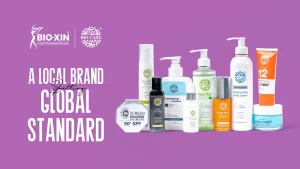Here’s what we found out:
What is a Juul?
The Juul is a portable nicotine delivery device, it’s designed as an alternative to smoking and effectively replicates the physical and sensory experience of a cigarette. Celebrated for its sleek vapor, and slick design, the Juul is shaped like a USB device, it senses when you inhale from the mouthpiece and heats up to vaporize the liquid inside, making you exhale minimal amount of smoke afterwards. The device is rechargeable and comes with a USB charger that can be connected to anywhere when you’re on the go.
What’s in it?
The Juul has two components, one end contains the battery and temperature regulation system and the other end contains the pod, which contains e-liquid. This e-liquid formula is patented and is best described as a mixture of nicotine salts, glycerol, propylene glycol, benzoic acid and distinct flavors. The nicotine salts replicate the cigarette experience whereas glycerol is used to add moisture to the solution. Glycerol is recognized as ‘generally safe’ by the FDA. Propylene Glycol is a synthetic compound whereas Benzoic Acid is both found naturally and produced synthetically. Both of these are approved additives for food, cosmetic and pharmaceutical products.
Why is Juul so popular?
If the Juul was a video game, it would be Fruit Ninja.
With ninja-like discretion and delightful fruit flavors, it’s no surprise that people are hooked to this. It’s slick and modern design largely contributes to it acting as a fashion statement – social media being the biggest testament to this. Juul has capitalized on this and deeper analysis into their marketing reveals how subtle yet effective it is.
Juul has evolved from a cigarette alternative to a lifestyle choice. It’s inspired viral memes and jokes all over the internet and currently has a cult following. Sadly, this popularity has influenced thousands of teenagers around the world, getting them hooked onto the device which many studies have deemed ‘a gateway to smoking’.
What are the health risks behind a Juul?
E-cigarettes might be a better alternative to combustible cigarettes, but they come with their fair share of risks. While it avoids the intake of carcinogens, a typical 5% Juul pod has the same amount of nicotine as 20 cigarettes, much more than other vaporizers.

Despite common belief, it’s never just vapor you’re inhaling. It’s vapor with nicotine, toxins, and irritants. This is harder to notice in a Juul because of the Nicotine Salt, but do not make the mistake of undermining its presence. Nicotine Salt is a patented formula that closely resembles that natural structure of nicotine found in tobacco leaves, which makes it more readily absorbed into our bloodstreams, enhancing damage. Flavoring enhances the harmful effects of these chemicals you’re inhaling. Despite all of this, Juul doesn’t have acute health risks but they will often aggravate asthma and other respiratory issues. Juul also has a much greater amount of Benzoic acid, 44.8mg/mL in comparison to other e-cigarettes which have it within a range of 0.2-2 mg/mL. It uses the properties of benzoic acid to increase the potency of nicotine salts in the e-liquid and strategically ignores how excessive exposure to benzoic acid leads to sore throats, coughs, abdominal pain, and nausea among other symptoms.
Ultimately, Juul is a marginal takeaway. You’re still ingesting the nicotine and a majority of harmful toxins, it’s just not wrapped up in paper. For developing brains, which is a large demographic of Juul users, this results in reduced activity in the prefrontal cortex of the brain – a critical area for decision making and cognitive behavior. These have all largely contributed to the Food and Drug Administration (FDA) cracking down on the e-cigarette industry recently.
Will a Juul help me quit smoking?
Developed as a satisfying alternative to cigarettes, the Juul webpage effectively brands multiple success stories of how people have replaced smoking with Juul. While a study sponsored by Juul suggests that it hasn’t only helped people cut down on smoking, but also leave it entirely. In other cases, they started consuming both cigarettes and vape at the same time – a dangerous phenomenon known as ‘dual use’, marked as positive because of decreased consumption. However, this study has its fair share of limitations. This study had 8000 people try Juul samples through an online process and respond to follow up questions 3 months later – a self-report procedure which isn’t verifiable. This process did not have a formal evaluation with biochemical testing and was largely inconsistent because of how it didn’t analyze a smoker’s exposure to toxins.

The lead author behind this paper, the founder of the Scotland based research consulting firm CSUR stated, “We are identifying that between 30% to 40% of smokers who take up the Juul manage to completely cease their smoking by 90 days,” as he remarked on this pivotal study. Other researchers weren’t convinced, and advised caution because of the possible conflict of interest. Coincidentally, studies were also sponsored in the past by big-tobacco companies to prove how their cigarettes were not harmful but rather beneficial to health.
While a lot of people have switched to Juul for economic reasons abroad, the same doesn’t apply to Bangladesh because of how cost-effective cigarettes are here in comparison to Juul. Check how much you’d be saving at: https://www.juul.com/calculator
How does a Juul compare to other e-cigarette alternatives?
Nicotine:
Most vaporizers have something known as freebase nicotine, which irritates the throat. On the other hand, the Nicotine salt in Juul avoids this and the discomfort in the chest and lungs. This not only makes the experience more pleasant but, it also ensures discretion and a pleasant odor.
However, Juul contains a greater amount of Nicotine than other vaporizers. Each pod contains 59mg of nicotine per milliliter of liquid, whereas typical e-cigarettes contain 5-30mg nicotine per milliliter. This greater nicotine amount was intentional, its creators ramped up the quantity of nicotine to make Juul more comparable to cigarettes. This has led to other e-cigarette manufacturers ramping up the nicotine quantity in their vaporizers as well.
E-Juice:
While most vaporizers have open systems, where you are allowed to refill the vape with bottles of e-juice, Juul follows a closed system in this regard. Users cannot refill the pod, they have to replace them – an important factor for quality control.
Design:
In comparison to other vaporizers and their bulky outlook, Juul has a very compact and convenient design. With inhalation sensors, it doesn’t require buttons and switches.
System:
Juul has a superior built-in temperature regulation system, this prevents ‘dry hits’ which occur when the vape cartridge gets too low on liquid. Similarly, Juul is less likely to over combust and overheat. Hence, there is no possibility of your Juul exploding in your face.
Flavor:
While the Juul comes in 8 flavors, Vaporizers have over 8000 flavors from 500+ brands. If you consider yourself an aficionado, Juul won’t do you justice.

What this means for the e-cigarette industry:
In recent days, Juul has had many successors. Myblu, Kandypens, PHIX are all notable competitors. While some manufacturers have started to increase their tobacco count, others are following the strategy of using the Juul design and mechanism to devise healthier alternatives. Modern tobacco is an evolutionary industry, with big tobacco brands like Philip Morris designing revolutionary devices like the IQOS – which merely heat the tobacco without burning it, to produce a flavor. Contrary to what cultural conservatives will say, this is good. In a few years, smokers will have healthier alternatives and this is a win for technology.
For now, we must sit back and watch the free market manifest in all of its beauty, and observe the rise of healthier alternatives. The Marlboro man doesn’t ride a horse bare-chested anymore, he rides a car, well dressed while he sucks on a USB device for hours on end.
The Takeaway:
If you’re already a smoker, Juul might be worth a shot. If you’re not, you should steer clear of it despite its aesthetic appeal. Juul as a company recognizes this phenomenon and works hard to reinforce age restrictions and prevention programs. It is important to remember, e-cigarettes aren’t the only alternative to smoking. Do your own research, consult a health care professional, find healthier addictions and figure out what’s right for you.






